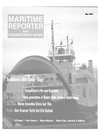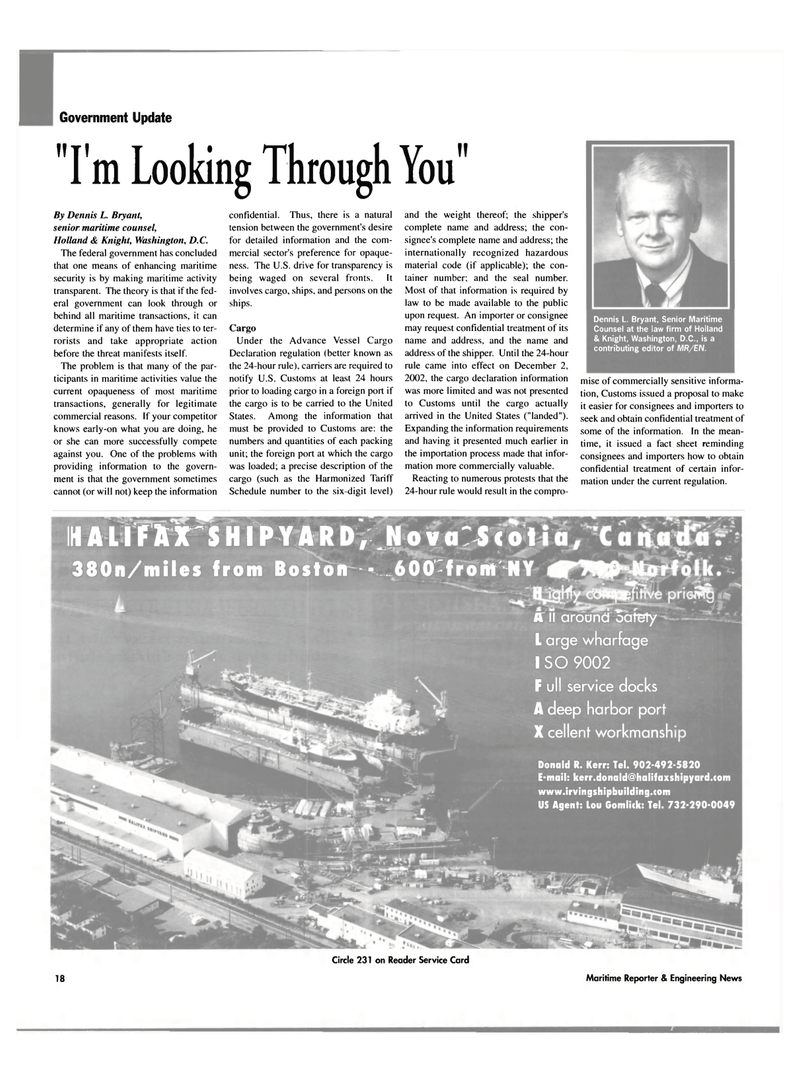
Page 18: of Maritime Reporter Magazine (May 2003)
Read this page in Pdf, Flash or Html5 edition of May 2003 Maritime Reporter Magazine
Government Update "I'm Looking Through You"
By Dennis L. Bryant, senior maritime counsel,
Holland <6 Knight, Washington, D.C.
The federal government has concluded that one means of enhancing maritime security is by making maritime activity transparent. The theory is that if the fed- eral government can look through or behind all maritime transactions, it can determine if any of them have ties to ter- rorists and take appropriate action before the threat manifests itself.
The problem is that many of the par- ticipants in maritime activities value the current opaqueness of most maritime transactions, generally for legitimate commercial reasons. If your competitor knows early-on what you are doing, he or she can more successfully compete against you. One of the problems with providing information to the govern- ment is that the government sometimes cannot (or will not) keep the information confidential. Thus, there is a natural tension between the government's desire for detailed information and the com- mercial sector's preference for opaque- ness. The U.S. drive for transparency is being waged on several fronts. It involves cargo, ships, and persons on the ships.
Cargo
Under the Advance Vessel Cargo
Declaration regulation (better known as the 24-hour rule), carriers are required to notify U.S. Customs at least 24 hours prior to loading cargo in a foreign port if the cargo is to be carried to the United
States. Among the information that must be provided to Customs are: the numbers and quantities of each packing unit; the foreign port at which the cargo was loaded; a precise description of the cargo (such as the Harmonized Tariff
Schedule number to the six-digit level) and the weight thereof; the shipper's complete name and address; the con- signee's complete name and address; the internationally recognized hazardous material code (if applicable); the con- tainer number; and the seal number.
Most of that information is required by law to be made available to the public upon request. An importer or consignee may request confidential treatment of its name and address, and the name and address of the shipper. Until the 24-hour rule came into effect on December 2, 2002, the cargo declaration information was more limited and was not presented to Customs until the cargo actually arrived in the United States ("landed").
Expanding the information requirements and having it presented much earlier in the importation process made that infor- mation more commercially valuable.
Reacting to numerous protests that the 24-hour rule would result in the compro-
Dennis L. Bryant, Senior Maritime
Counsel at the law firm of Holland & Knight, Washington, D.C., is a contributing editor of MR/EN. mise of commercially sensitive informa- tion, Customs issued a proposal to make it easier for consignees and importers to seek and obtain confidential treatment of some of the information. In the mean- time, it issued a fact sheet reminding consignees and importers how to obtain confidential treatment of certain infor- mation under the current regulation.
HALIFAX SHIPYARD, Nova Scot 380n/miles from Boston—* 600 front NY
A II around oatety
L arge wharfage
I SO 9002
I ull service docks
A deep harbor port
X cellerit workmansh
Donald R. Kerr: Tel. 902-492-5820
E-mail: kerr.donald@halifaxshipyard. US Agent: Lou Gomlick: Tel. 732-290-0049
Circle 231 on Reader Service Card
18 Maritime Reporter & Engineering News

 17
17

 19
19
